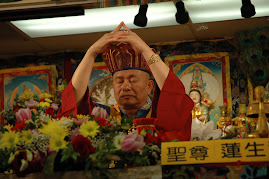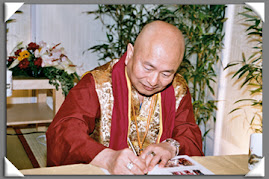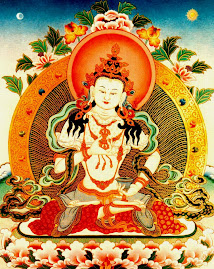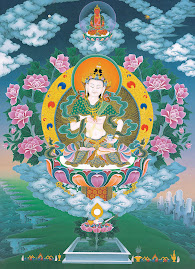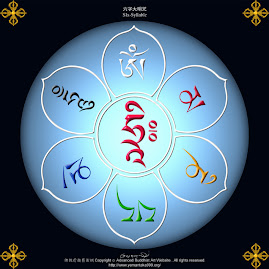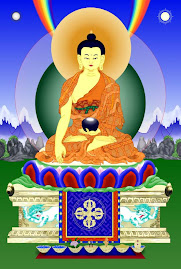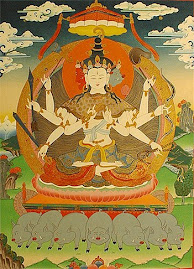
KALACHAKRA SPECIFIC PRECEPTS:
Six Types of Precepts for Upholding Buddhas
1. Upholding Akshobhya: Generate Bodhicita by committing to attain enlightenment and benefit all sentient beings, act upon the Three Basic Teachings of Buddhism (avoid evils, develop virtues and purify oneself), uphold the vajra scepter, uphold the vajra bell, uphold the mudra of the Buddha's body, and revere the Root Guru.
2. Upholding Ratnasambhawa: Unselfishly contribute one's own wealth and belongings, apply Buddhadharma to guide and help others, overcome their difficulties and protect their safety.
3. Upholding Vairocana: Use five meats and five fluids as wondrous potion to assist one's attainment.
4. Upholding Amoghasiddhi: Make frequent offerings to the Root Guru and the Three Treasures.
5. Upholding Amitabha: Guard the leakage of semen (white bodhicitta).
6. Upholding Vajrasattva: Train in developing the wisdom of non-dualism of emptiness and bliss.
Kalachakra Mandalas
The Kalachakra mandala is a cosmographic representation of the inner, outer, and alternative dimensions of reality. A support for tantric contemplative practice, mandalas are regarded as the actual abode of a particular deity. Presenting the sphere of the deity's presence, the deity's surrounds and the range and depth of a deity's influence, mandalas are meditation devices for actualizing and embodying a specific sublime form.
Encompassing the body, speech and mind of the Kalachakra deity along with the 636 complementary deities in the mandala, the Kalachakra mandala is particularly complex. For this reason, there is an emphasis within the Tibetan Buddhist tantric practice traditions of using supports for contemplation such as replicas of the actual mandala including thangka paintings, 3D constructions, and now computer-generated animations for imagining or visualizing the Kalachakra mandala. What follows are a selection of mandalas of the Kalachakra as a 3-dimensional animation, as photographs of 3-dimensional representations of the mandala, and as traditional thangka painting depictions of the Kalachakra.
Kalachakra Authentic Twenty-Five Prohibited Conducts
A. Five Primary Prohibitive Conducts (Five Basic Precepts):
1. Killing
2. Stealing
3. Engaging in sexual misconduct
4. Not telling the truth
5. Being intoxicated
B. Five Secondary Prohibitive Conducts:
1. Gambling
2. Earning a living through unvirtuous means
3.
4. Killing for the purpose of praying to ancestors or spirits (gods, ghosts, etc.)
5. Believing in deviant teachings or paths
C. Five Severe Killing ill-deeds:
1. Killing a man
2. Killing a woman
3. Killing a baby
4. Killing a cow
5. Destroying temples, pagodas or buddha statues
D. Five Harming ill-deeds:
1. Harming a buddha or teacher
2. Harming a sangha member
3. Harming a friend
4. Harming a leader
5. Harming a confidant
E. Five Desirous ill-deeds:
1. Eyes craving beauty
2. Ears craving beautiful sounds
3. Nose craving nice fragrances
4. Mouth craving good taste
5. Body craving pleasures
1. Disrespectful towards the lineage Root Guru, disturbing the mind of the Root Guru
2. Deviating from guidance or directives from the Root Guru
3. Creating discord, speaking faults of Vajra brothers and sisters, not cooperating with other Vajra members
4. Lack of compassionate heart towards sentient beings
5. Willingly losing white boddhicitta
6. Slandering Mahayana Buddhism and the realization of emptiness through Mahayana practices
7. Revealing Tantra secrets to the unripened practitioners
8. Disregarding the well being of one’s own body, practicing austerity that is harmful to health, despising one`s own five aggregates which are five Buddha embodiments
9. Abandoning, rejecting or opposing Empty Nature
10. Being hypocritical and inconsistent between inner thoughts and outer conduct
11. Doubting or despising Root Guru`s teaching of the wisdom of Supreme Immutable Bliss
12. Using ordinary viewpoint and concept to judge a true yogi/yogini, slandering his/her behavior that does not fit the norm
13. Holding onto one`s own opinion, not committing body and mind to the pledged Tantra precepts
14. Deriding women
Kalachakra Authentic Eight Secondary Root Infractions
1. Engaging in Consort Practice without proper Tantric empowerments (Anyone who is disqualified to receive empowerments or to practice Tantra, anyone who violates the precepts and break his/her vows cannot engage in consort practice)
2. Engaging in Consort Practice without fulfilling the three unities (Inability to merge body, speech and mind with the deity)
3. Transmitting Tantra prior to maturity (Revealing pictures, Tantra texts, mudra or dharma implements of consort practice to the uninitiated or non-believers)
4. Disputing at the time of assembly (Creating dispute at the time of dharma ceremony, group practice, offering rites, etc)
5. Lying to devout practitioners (Misleading or not answering dharma questions asked by fully qualified or devout Tantric practitioners)
6. Staying seven days at the place of a Pratyeka Buddha (Stream-hearer) (Staying more than one week at the home of a Hinayana practitioner that lacks Tantric belief or slanders Tantra)
7. Bearing arrogance prior to realization (Prior to attaining true realization, exaggerating one's own fruition and spiritual power)
8. Transmitting dharma to non-believers (Transmitting secret dharma essences to non-believers)
Note: The above precepts are authentic Tantra infractions for consort practitioners, however,
* In front of the Root Guru (spiritual teacher of heart), sincerely generate heartfelt repentance and then pray for another bestowal of empowerment.
* Practice Homa retreat and sincerely generate heartfelt repentance. Make Homa offering to the Root Guru, all lineage gurus and Buddhas and then pray for another bestowal of empowerment.
* In front of the altar, sincerely generate heartfelt repentance and chant Vajrasattva Hundred Syllable Mantra more than one hundred thousand times and then pray for another bestowal of empowerment.















